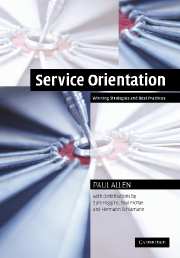Book contents
- Frontmatter
- Contents
- Foreword
- Preface
- Acknowledgments
- List of acronyms and abbreviations
- PART 1 OVERVIEW
- 1 Basics of service orientation
- 2 Execution management
- 3 Business process management
- PART 2 BUSINESS ARCHITECTURE
- PART 3 SERVICE-ORIENTED ARCHITECTURE
- PART 4 SERVICE-ORIENTED MANAGEMENT
- PART 5 CASE STUDIES
- References
- Useful sources of information
- Index
3 - Business process management
from PART 1 - OVERVIEW
Published online by Cambridge University Press: 31 July 2009
- Frontmatter
- Contents
- Foreword
- Preface
- Acknowledgments
- List of acronyms and abbreviations
- PART 1 OVERVIEW
- 1 Basics of service orientation
- 2 Execution management
- 3 Business process management
- PART 2 BUSINESS ARCHITECTURE
- PART 3 SERVICE-ORIENTED ARCHITECTURE
- PART 4 SERVICE-ORIENTED MANAGEMENT
- PART 5 CASE STUDIES
- References
- Useful sources of information
- Index
Summary
Cultural shifts
In this chapter we outline the BPM technologies and the associated gear shifts in business modeling that are required for effective service orientation. We first take a brief detour into the history of BPM technology before outlining the key elements of an effective BPM solution and previewing the main differences between a service-oriented approach and traditional approaches to business modeling. In this section, by way of prelude, we take a look at some of the cultural shifts involved.
It is important to restate some ground rules up front. We are focusing in this chapter on services as a way of enabling federated business processes (note for brevity we will refer to “business process” as “process” throughout, unless the context requires otherwise). Software services are services offered in software. Web services are but one manifestation – albeit a very compelling one – of software services. We shall therefore (as before) refer specifically to Web services, rather than software services, only where context demands it – as, for example, in the technology background to BPM.
Cultural shifts in IT
IT organizations continue to find themselves under increased pressure to find ways of doing more with less. In many cases, the development and integration efforts of the 1980s were designed to increase organizational efficiency by automating departmental functions. In the 1990s, the agenda moved toward using automation to help streamline internal processes and to removing the “white space” (Rummler and Brache, 1995) on the organization chart.
- Type
- Chapter
- Information
- Service OrientationWinning Strategies and Best Practices, pp. 42 - 56Publisher: Cambridge University PressPrint publication year: 2006

